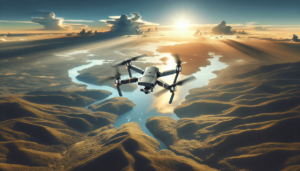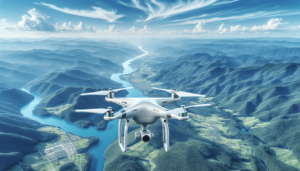Have you ever looked at stunning aerial photography and wondered how some photographers capture such breathtaking images while others miss the mark entirely? It’s a bit like trying to bake a cake without following a recipe; sometimes, you end up with something fluffy and delightful, and other times, well—it’s more of a pancake situation. Our mission today is to help you steer clear of those flat pancake moments by sharing some common pitfalls in aerial photography. So, let’s unfold the drone advice scroll and navigate through these skies together.
Understanding Your Equipment
We can’t stress this enough: knowing your gear inside and out will save you a ton of headaches. Trust us, no one wants to find themselves frantically flipping through a user manual while their drone hovers precariously overhead.
Familiarizing Yourself with Drone Features
Drones come with a myriad of features, and while they might seem overwhelming at first, getting a good grasp on them is crucial. Take the time to read your drone’s manual, watch tutorials, and perhaps even join some online forums. This preparation is like knowing where all the streets lead in a new city—you’ll certainly enjoy the journey more if you’re not accidentally backing up into a one-way road.
Importance of Regular Maintenance
Neglecting maintenance is one of those things that seems perfectly fine until it’s not. Imagine finding the perfect shot only to have a minor mechanical issue cut your flight short. Regularly checking your drone’s propellers, battery life, and software updates can help avoid these mid-air mishaps. Think of it like brushing your teeth—not thrilling, but absolutely necessary.
Planning Your Flight
Jumping into the air without a plan is like heading to the grocery store and realizing you don’t have your shopping list. Let’s talk about getting organized before taking flight—it’ll save us from wandering aimlessly (or worse, into restricted airspace).
Scouting Locations Safely
It’s tempting to just go with the flow, but taking time to scout locations will ensure you’re prepared for whatever the sky throws at you. Familiarize yourself with the area’s layout and any potential hazards. Checking for weather updates is as vital as packing an umbrella and not just hoping for the best.
Understanding Local Regulations
Flying blindly into legal trouble is a situation we’d all rather avoid. Regulations vary, so researching the specific rules in your target area is as crucial as knowing the right day to take your trash out. Trust us, it’s worth the effort to prevent any potential legal snarls.
![Avoid These 9 Common Aerial Photography Mistakes [Expert Advice] Avoid These 9 Common Aerial Photography Mistakes [Expert Advice]](https://droneaperture.com/wp-content/uploads/2025/01/avoid-these-9-common-aerial-photography-mistakes-expert-advice-1024x585.png)
Mistake 1: Neglecting Composition Principles
One of the most common errors in aerial photography is ignoring traditional composition principles. A mesmerizing view from above doesn’t always translate into an engaging photograph. Let’s explore how to structure your shots to captivate your audience.
Rule of Thirds
While it might seem trivial, the rule of thirds can turn a good shot into a great one. Imagine your frame split into nine equal parts—placing your subject along these lines instantly enhances the visual appeal. It’s like adding a bit of spice to your favorite recipe.
Framing Techniques
Using natural elements to frame your shots can add depth and character. Trees, buildings, or even shadows can create a frame that draws the viewer’s eye right to your subject. It’s that touch of storytelling through your lens.
Mistake 2: Overlooking Lighting Conditions
Good lighting is the unsung hero of photography. Shooting at the wrong time of day can turn what could be a stellar shot into something that falls flat. Let’s ensure your photos shine as brightly as your creative ideas.
Golden Hour vs. Blue Hour
The golden and blue hours are akin to nature’s filter, imbuing your images with a unique warmth or coolness. These periods provide a softer light that enhances textures and reduces harsh shadows. Think of them as nature’s own Instagram filter—but better.
Avoiding Direct Sun
While it may seem counterintuitive, midday sun isn’t your friend. The harsh light casts hard shadows and washes out details. Aim to shoot when the light is softer and more diffused, allowing your subjects to stand out with vivid clarity.
![Avoid These 9 Common Aerial Photography Mistakes [Expert Advice] Avoid These 9 Common Aerial Photography Mistakes [Expert Advice]](https://droneaperture.com/wp-content/uploads/2025/01/avoid-these-9-common-aerial-photography-mistakes-expert-advice-1-1024x585.png)
Mistake 3: Flying Too High or Too Low
Finding the right altitude is like hitting the jackpot in Goldilocks terms; not too high, not too low—just right. Both extremes have their challenges, but navigating this with precision will capture perspectives that resonate well.
Finding the ‘Sweet Spot’
Every situation demands a different altitude, but generally speaking, staying between 100 and 400 feet strikes a good balance. This range allows you to capture broad views while still maintaining detail. It’s like finding that perfect seat at the theater—close enough to see expressions, but far enough for a comprehensive view.
Adapting to Your Subject
Whether urban landscapes or natural vistas, different subjects call for varied altitudes. Practice adjusting your altitude to what best suits the scenario and experiment until it feels intuitive. You wouldn’t wear sandals in snow any more than you should stick to one elevation in all conditions.
Mistake 4: Ignoring Post-Processing
The magic of aerial photography doesn’t end once you’ve captured the shot. Much like polishing a gem, post-processing can enhance the beauty of what you’ve already achieved. Let’s roll up our sleeves and give those photos the finishing touch they deserve.
Importance of Editing Software
Having a solid editing tool is akin to equipping yourself with a Swiss Army knife—versatile and indispensable. Programs like Adobe Lightroom or Photoshop can help refine your images, perfecting elements like contrast, warmth, and focus until your imagery truly sings.
Avoiding Over-Editing
While editing is essential, restraint is key. It’s easy to cross from enhancement into overdone territory. Aim for subtle adjustments that elevate rather than overshadow the original photo. It’s similar to seasoning a dish; too much and it overpowers, just enough and it enhances.
Mistake 5: Rushing the Process
Patience is indeed a virtue, and when it comes to aerial photography, rushing is often counterproductive. Let’s take a moment to understand the value of slowing down and allowing creativity to flow at its own pace.
Taking Time to Explore
Allowing yourself the time to explore a scene means you’re more likely to notice interesting details. Instead of swooping in and out, circle your subject, adjust angles, and wait for the best lighting conditions. It’s the photographic equivalent of savoring a good meal rather than wolfing it down.
Embrace the Process
Enjoyment can sometimes be overshadowed by the pressure to rapidly produce. Instead, pause to appreciate the splendor of the world from above, which often leads to discovering unexpected photographic gems. After all, art flourishes when it isn’t rushed.
Mistake 6: Focusing Solely on Technology
While tech can be exhilarating, letting it overshadow the artistic aspect of photography can lead to sterile images. Balancing technology with creativity is what sets truly remarkable photography apart.
Prioritizing the Story
Every photo tells a story, and it’s crucial to ensure yours is apparent. Be intentional with your shots—let emotion and narrative guide your lens, integrating technical elements when they serve the bigger picture. Your creativity is the author; your drone is merely the pen.
Staying Grounded
Staying too focused on technical prowess can inhibit creativity. Balance your enthusiasm for gadgets by connecting with the scene on a personal level, honing in on what makes it unique to you. This connection often translates into more emotive and impactful imagery.
Mistake 7: Failing to Account for Weather
Weather is a whimsical companion that can dramatically change how scenes are captured. Ignoring its attributes can lead to missed opportunities—or worse, compromised equipment.
Forecast Check
Before heading out, checking the weather forecast is pivotal. Light rain or strong winds can ruin even the most meticulously planned shoot. Come prepared, with rain covers or appropriate gear, to safeguard your outing and your drone.
Embrace Weather’s Quirks
Sometimes, less-than-ideal weather can result in the most dynamic photos. Clouds that create dramatic lighting or reflections off a recent rain add unexpected layers to your composition. Use weather to tell a compelling and unique story.
Mistake 8: Not Prioritizing Safety
Safety may not be glamorous, but it’s vital to a successful aerial photography venture. Neglecting safety measures can lead to equipment loss or injury, which is a poor trade for any photograph.
Pre-Flight Checklist
Before any flight, run through a complete checklist. Assess battery life, confirm calibration, double-check settings, and ensure you’re clear of obstacles and aircraft. This habit ensures both you and your drone are clear to fly safely and successfully.
Respect Privacy
With great height comes great responsibility. Ensuring you respect privacy and adhere to legal guidelines prevents conflicts and promotes ethical practices. Let’s keep our eyes on creating art, not duplicity.
Mistake 9: Overlooking Storytelling Elements
At the core of any impactful photo lies a compelling story. Omit to weave narrative elements into your pictures, and you might find they lack depth or connection.
Weaving Stories into Photos
Think about the narrative you want to share with your audience. Whether capturing bustling cityscapes or serene rural settings, nurturing a central theme or story enhances viewer engagement. What story are you sharing with the world?
Utilizing Perspective
Using different perspectives can shift the narrative’s tone, adding energy or tranquility as needed. Experiment with varying angles and focal points to see how they affect the story you’re telling. Imagine each drop of perspective as a brushstroke on your creative canvas.
In the ever-evolving dance of aerial photography, avoiding these nine common mistakes will place us on the path to creating more impactful, meaningful, and ethereal images. By being mindful in our preparation, we not only elevate our photography but also enrich the stories we’re able to share from the sky. Together, let’s use our bird’s eye view both wisely and wonderfully.
![7 Essential Aerial Photography Tips For Beginners [2025]](https://droneaperture.com/wp-content/uploads/2025/01/7-essential-aerial-photography-tips-for-beginners-2025-1-300x171.png)

